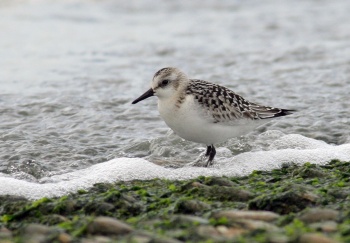- Calidris alba
Identification

Photo © by Dave Hutton
Farmoor Reservoir, Oxfordshire, England, May 2007
Length 20-21 cm (7¾-8¼ in), wingspan 35-39 cm, weight 41-102 g.
A relatively small wader with a straight, stubby, black bill. The legs are black and of medium length and uniquely among Calidris species, lacking a hind toe.
Underparts always pure white. Summer plumage with brick-red to orange-tinged grey head and upper breast; mantle spangled orange, black and silver. Males tend to be brighter orange and females paler, more silvery. Winter adults plain silvery grey, with blackish primaries and a dark carpal ("shoulder") patch.
Juveniles spangled with black and silver to pale yellow-buff above.
Flight
In flight, strong white wingbar more conspicuous than in any other Calidris species.
Confusion species
Summer adults can be confused with summer adult Red-necked Stint and Little Stint; Sanderling differs in being significantly larger, and in close views, by lacking a hind toe. The behaviour, fast running on sandy shores, is also usually distinct, though vagrant Sanderlings in muddy habitats can behave more stint-like.
Distribution
Breeds in the far-northern Holarctic (concentrations in Canada, Greenland and Siberia); non-breeding range is on coasts worldwide (for example, a bird breeding in Greenland may winter anywhere from northern Europe to South Africa). A migrant (spring and autumn) and winter visitor to Britain. Rarely seen any distance inland.
Taxonomy
Treated by some authorities as monotypic[1], while other authorities[2][3] recognise two subspecies:
- Calidris alba alba - breeds northeastern Canada, Greenland, Svalbard, and northern Siberia
- Calidris alba rubida - breeds north-central Canada and northern Alaska
The two subspecies are very similar, distinguished only by small differences in morphometrics[2]
Habitat
Nesting habitat is rocky tundra, while coasts and especially sandy beaches are used the rest of the year.
Behaviour
Typically runs very fast on sandy beaches at the edge of the waves, roosts in tight flocks on beaches or rocky outcrops just above the high water mark.
Diet
Forages in flocks on beaches, usually in moist sand. The diet includes crustaceans, small marine worms, insects, fish and molluscs.
Breeding
Three or four eggs are laid in a ground scrape. Some females lay one clutch which is then attended by both parents; others lay one clutch which they leave for the male to attend and shortly after a second clutch which is only attended by the female.
References
- Clements, J. F., T. S. Schulenberg, M. J. Iliff, D. Roberson, T. A. Fredericks, B. L. Sullivan, and C. L. Wood. 2017. The eBird/Clements checklist of birds of the world: v2017, with updates to August 2017. Downloaded from http://www.birds.cornell.edu/clementschecklist/download/
- Engelmoer, M., & Roselaar, C. S. (1998). Geographical Variation in Waders. Kluwer Academic Publishers, Dordrecht. ISBN 9780792350200.
- Gill, F and D Donsker (Eds). 2015. IOC World Bird Names (version 5.3). Available at http://www.worldbirdnames.org/.
- Hockey, PAR, WRJ Dean, and PG Ryan, eds. 2005. Roberts' Birds of Southern Africa. 7th ed. Cape Town: John Voelcker Bird Book Fund. ISBN 978-0620340533
- RSPB
- Sinclair, I and P Ryan. 2003. Birds of Africa South of the Sahara. Princeton: Princeton Univ. Press. ISBN 978-0691118154
- The Sanderling study group homepage
Recommended Citation
- BirdForum Opus contributors. (2024) Sanderling. In: BirdForum, the forum for wild birds and birding. Retrieved 27 December 2024 from https://www.birdforum.net/opus/Sanderling
External Links
GSearch checked for 2020 platform.1






